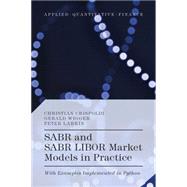SABR and SABR Libor Market Models in Practice is an accessible guide to modern interest rate modelling. Rather than covering an array of models which are seldom used in practice, it focuses on the SABR model, the market standard for vanilla products, the LIBOR Market Model, the most commonly used model for exotic products and the extended SABR LIBOR Market Model. The book takes a hands-on approach, demonstrating simply how to implement and work with these models in a market setting. It bridges the gap between the understanding of the models from a conceptual and mathematical perspective and the actual implementation by supplementing the interest rate theory with modelling specific, practical code examples written in Python.

SABR and SABR LIBOR Market Models in Practice With Examples Implemented in Python
by Crispoldi, Christian; Wigger, Gérald; Larkin, Peter-

This Item Qualifies for Free Shipping!*
*Excludes marketplace orders.
Rent Textbook
Rent Digital
New Textbook
We're Sorry
Sold Out
Used Textbook
We're Sorry
Sold Out
How Marketplace Works:
- This item is offered by an independent seller and not shipped from our warehouse
- Item details like edition and cover design may differ from our description; see seller's comments before ordering.
- Sellers much confirm and ship within two business days; otherwise, the order will be cancelled and refunded.
- Marketplace purchases cannot be returned to eCampus.com. Contact the seller directly for inquiries; if no response within two days, contact customer service.
- Additional shipping costs apply to Marketplace purchases. Review shipping costs at checkout.
Summary
SABR and SABR Libor Market Models in Practice is an accessible guide to modern interest rate modelling. Rather than covering an array of models which are seldom used in practice, it focuses on the SABR model, the market standard for vanilla products, the LIBOR Market Model, the most commonly used model for exotic products and the extended SABR LIBOR Market Model. The book takes a hands-on approach, demonstrating simply how to implement and work with these models in a market setting. It bridges the gap between the understanding of the models from a conceptual and mathematical perspective and the actual implementation by supplementing the interest rate theory with modelling specific, practical code examples written in Python.
Author Biography
Peter Larkin is a Data Scientist working on building predictive models using big data in the (re)insurance industry. Previously he worked as a Quantitative Analyst in the financial services industry working on projects spanning the pricing of structured products, credit and market risk, and asset management. Peter has a background in Theoretical Physics and received his Ph.D from the University of York in 2008, previously having studied at Cambridge University and Imperial College London. In 2012 he also completed a MSc in Mathematical Finance from the University of Oxford.
Gerald Wigger is Head of Quantitative Analysis at Weisshorn Re. He previously worked in various responsible roles such as Head of Pricing at Axa Winterthur, Head of Risk Modeling at Zürcher Kantonalbank and Interest Rate Derivatives Quant at Bank of America Merril Lynch. Gerald Wigger holds a PhD in Solid State Physics from ETH Zuerich.
Table of Contents
1.1. Who Should Read This Book
1.2. Outline
1.3. Python, NumPy and SciPy
2. Interest Rate Derivatives Markets
2.1. Interest Rates
2.2. What You Need for Trading: ISDAs, Netting Agreement and CSAs
2.3. The Evolution of Complex Derivatives Trading
2.4. The Effects of the Financial Credit Crisis
3. Interest Rate Notions
3.1. Interest Rate Basics
3.2. The Multiple Curve Framework
3.3. Interest Rate Valuations and Measures
3.4. Volatility Trading
3.4.2. Swaptions
4. Vanilla Models
4.1. Lognormal Black Model
4.2. Normal Model
4.3. Risk Sensitivities
5. SABR Model
5.1. Introduction
5.2. SABR Parameters
5.3. PDE and Kolmogorov Equations
5.4. Hagan et al. Approximations
5.5. SABR Calibration in Practice
5.6. Risk Sensitivities
5.7. Monte Carlo Simulation Schemes for SABR
5.8. The Limits of Hagan et al. Approximations
5.9. Alternative SABR Approximations
5.10. Pricing in a Negative Forward Rate Regime: Shifted SABR Approximation
6. LIBOR Market Model
6.1. Introduction
6.1.1. Short Rate Models
6.2. Dynamics of the LIBOR Market Model
6.3. The Forward-Forward Correlation and Its Calibration
Nelson Siegel Approach
6.4. Volatility Parametrization and Calibration
6.5. Simulation
6.6. Risk Sensitivities
7. SABR LIBOR Market Model
7.1. Introduction
7.2. Dynamics of the SABR LIBOR Market Model
7.3. The Correlation Matrix and Its Calibration
7.4. Rebonato et al. SABR LMM Parametrization
7.5. Simulation and Pricing
A. Appendices
A.1. Time Grid and Day Count Conventions
A.2. A Note On Hyperbolic Geometry
A.3. LIBOR Market Model in the HJM Framework
A.4. Swap Market Model
An electronic version of this book is available through VitalSource.
This book is viewable on PC, Mac, iPhone, iPad, iPod Touch, and most smartphones.
By purchasing, you will be able to view this book online, as well as download it, for the chosen number of days.
Digital License
You are licensing a digital product for a set duration. Durations are set forth in the product description, with "Lifetime" typically meaning five (5) years of online access and permanent download to a supported device. All licenses are non-transferable.
More details can be found here.
A downloadable version of this book is available through the eCampus Reader or compatible Adobe readers.
Applications are available on iOS, Android, PC, Mac, and Windows Mobile platforms.
Please view the compatibility matrix prior to purchase.